您好,登錄后才能下訂單哦!
您好,登錄后才能下訂單哦!
本篇文章給大家分享的是有關如何分析NumPy廣播機制與C語言擴展,小編覺得挺實用的,因此分享給大家學習,希望大家閱讀完這篇文章后可以有所收獲,話不多說,跟著小編一起來看看吧。
重點介紹廣播機制以及針對高維數組的軸操作,最后對 NumPy 的 C 語言擴展作了介紹。
NumPy 運算通常是在兩個數組的元素級別上進行的。最簡單情況就是,兩個具有完全相同 shape 的數組運算,如下面例子所示,

a = np.array([1.0, 2.0, 3.0])
b = np.array([2.0, 2.0, 2.0])
a * b
numpy 的廣播機制是指在執行算術運算時處理不同 shape 的數組的方式。在一定規則下,較小的數組在較大的數組上廣播,從而使得數組具有兼容的 shape。
a = np.array([1.0, 2.0, 3.0])
b = 2.0
a * b
在兩個數組上執行運算時,NumPy 比較它們的形狀。它從 shape 的最右邊開始往左一一比較。如果所有位子比較下來都是下面兩種情況之一,
那么這兩個數組可以運算。如果不滿足這些條件,則將引發 ValueError,表明數組的 shape 不兼容。
可見,數組的 shape 好比人的八字,兩個人如果八字不合,那是不能在一起滴。
在下面這些示例中,A 和 B 數組中長度為 1 的那些軸(缺失的軸自動補 1),在廣播期間會擴展為另一個數組相同位子上更大的長度,
A (3d array): 15 x 3 x 5
B (3d array): 15 x 1 x 5
Result (3d array): 15 x 3 x 5
A (3d array): 15 x 3 x 5
B (2d array): 3 x 5
Result (3d array): 15 x 3 x 5
A (3d array): 15 x 3 x 5
B (2d array): 3 x 1
Result (3d array): 15 x 3 x 5
A (4d array): 8 x 1 x 6 x 1
B (3d array): 7 x 1 x 5
Result (4d array): 8 x 7 x 6 x 5
下面例子中第一個數組的 shape 為 (3,3),第二個數組的 shape 為 (3,),此時相當于 (1,3),因此先將第二個數組的 shape 改為 (3,3),相當于原來數組沿著 0 軸再復制 2 份。
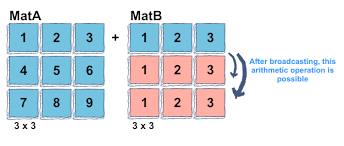
MatA = np.array([[1, 2, 3],[4,5,6],[7,8,9]])
MatB = np.array([1, 2, 3])
MatA + MatB
為了更好地理解這個機制,下面再給出幾個例子。下圖共三行,分別對應三種廣播方式,請對照后面代碼。
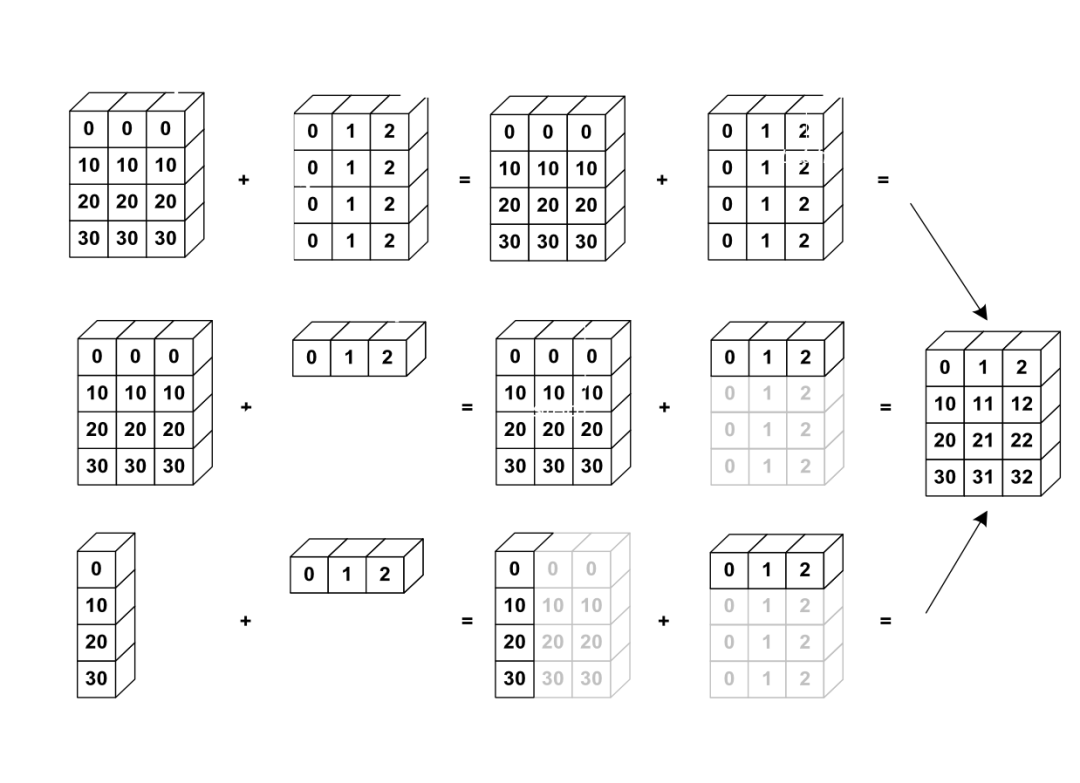
a = np.array([0,10,20,30])
b = np.array([0,1,2])
A = np.stack((a,a,a), axis=1)
B = np.stack((b,b,b,b))
# 對應第一種情況
A + B
# 對應第二種情況
A + b
a1 = np.array([[0,10,20,30]]).T
# 對應第三種情況
a1 + b
而下面例子不滿足廣播規則,因而不能執行運算。
A (1d array): 3
B (1d array): 4 # 倒數最后的軸長度不兼容
A (2d array): 4 x 3
B (1d array): 4 # 倒數最后的軸長度不兼容
A (2d array): 2 x 1
B (3d array): 8 x 4 x 3 # 倒數第二個軸長度不兼容
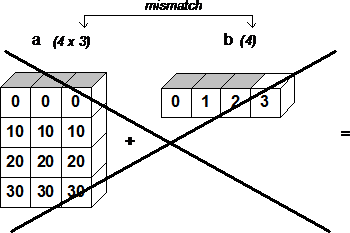
在需要增加軸的位子使用 np.newaxis 或者 None。
x = np.arange(6).reshape(2,3)
x, x.shape
x1 = x[:,np.newaxis,:]
x1, x1.shape
# 或者
x2 = x[:,None,:]
x2, x2.shape
numpy.squeeze( )x = np.arange(6).reshape(2,1,3)
y = x.squeeze()
xd = x.__array_interface__['data'][0]
yd = y.__array_interface__['data'][0]
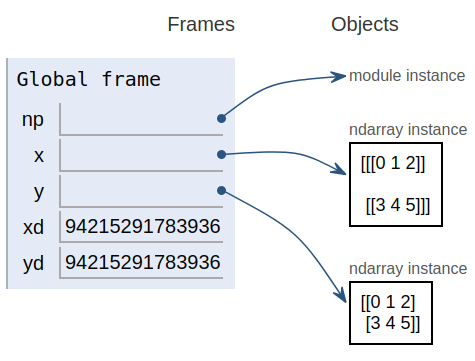
x = np.arange(9).reshape(3, 3)
y = np.transpose(x) # 或者 y = x.transpose() 或者 x.T
y = np.transpose(x, [1, 0])
x = np.array([3,2,1,0,4,5,6,7,8,9,10,11,12,13,14,15]).reshape(2, 2, 4)
y1 = np.transpose(x, [1, 0, 2])
請對照下圖理解這個三維數組在內存中的樣子以及對它的不同視圖(view)。關于這點,文末附上的進階篇有詳細解讀。
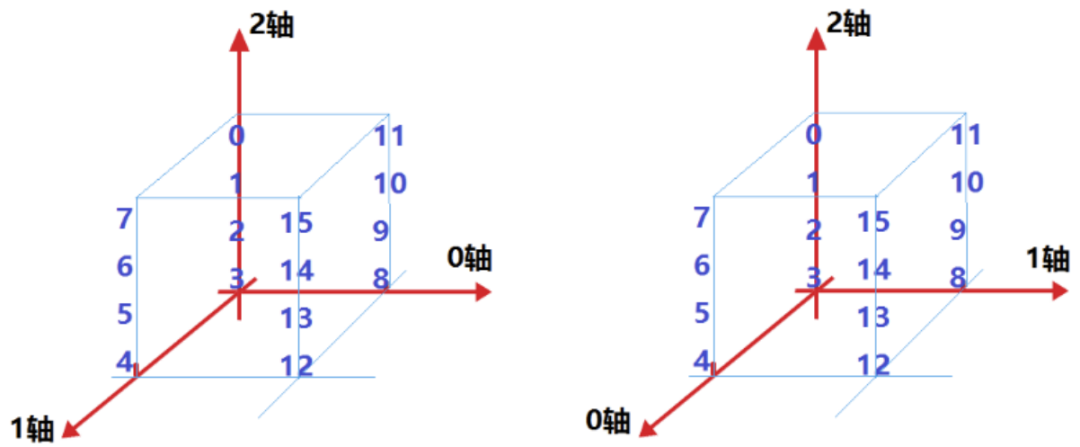
y2 = np.transpose(x, [2, 0, 1])
# 代碼放一起
x = np.array([3,2,1,0,4,5,6,7,8,9,10,11,12,13,14,15]).reshape(2, 2, 4)
y0 = np.transpose(x, [1, 2, 0])
y1 = np.transpose(x, [1, 0, 2])
y2 = np.transpose(x, [2, 0, 1])
看看變軸后各個數組的元素具體是怎樣的,注意,它們都指向同一份數據。
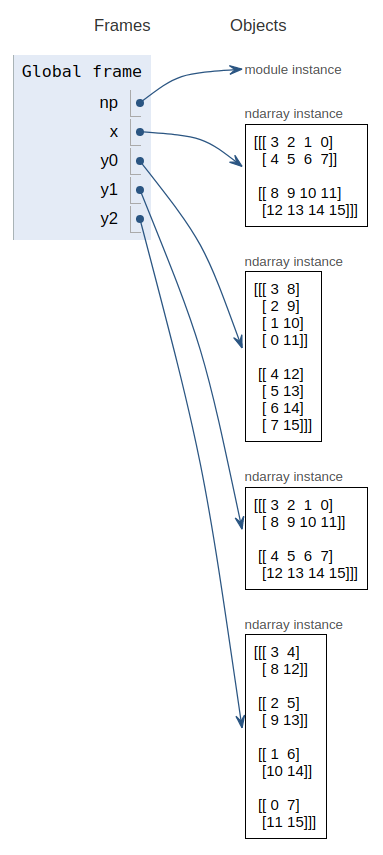
這是怎么實現對內存中同一份數據使用不同的軸序呢?實際上,數據還是那些數據,更改的是各個軸上的步長 stride。
x.strides, y1.strides, y2.strides
# 數據還是同一份
id(x.data), id(y1.data), id(y2.data)
再看一個例子,三維數組有三個軸,注意換軸后每個軸的步長。
x = np.arange(16).reshape(2, 2, 4)
y = x.transpose((1, 0, 2))
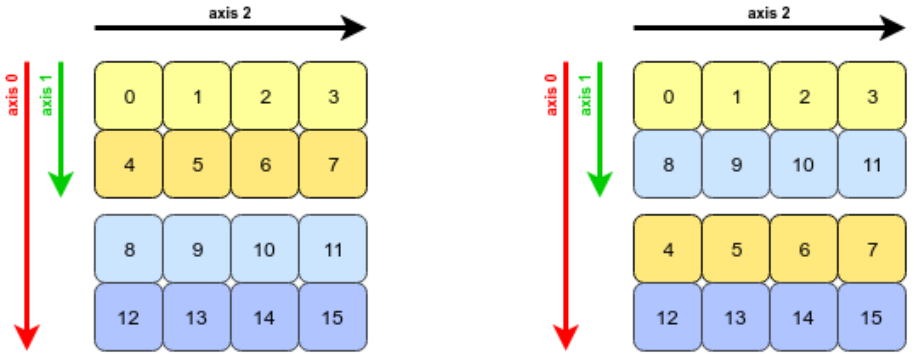
兩個數組三個軸對應的步長不同了。

軸更換后,下標也跟著換了,所以換軸前后相同下標指向的數據是不同的。
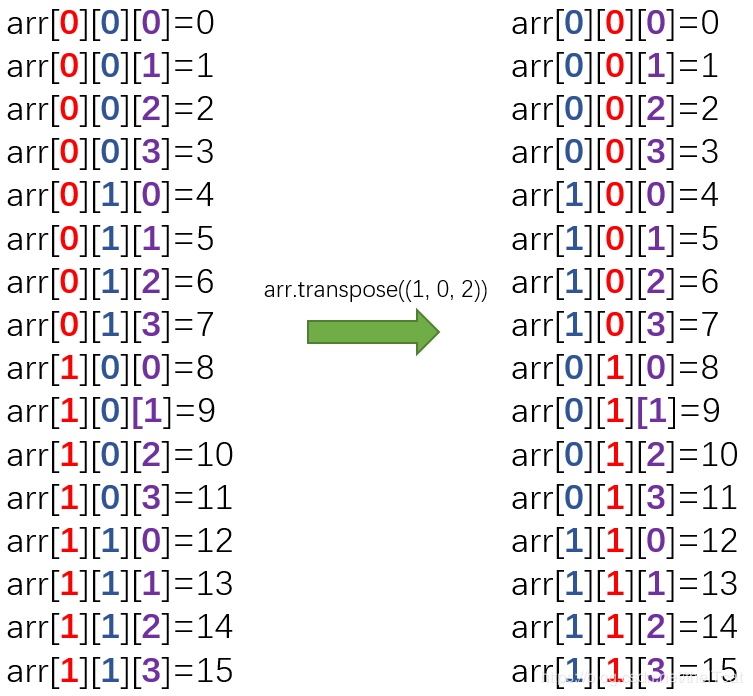
RGB 圖像數據
32×32 的二維數組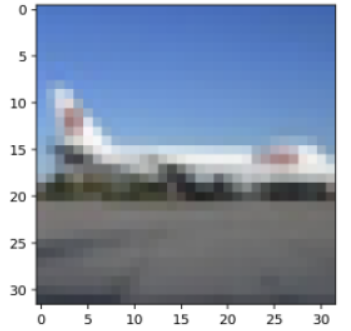
看下圖,從左到右,分別對應圖像數據在內存中的存放,將一維數組轉化為三維數組,更換軸。
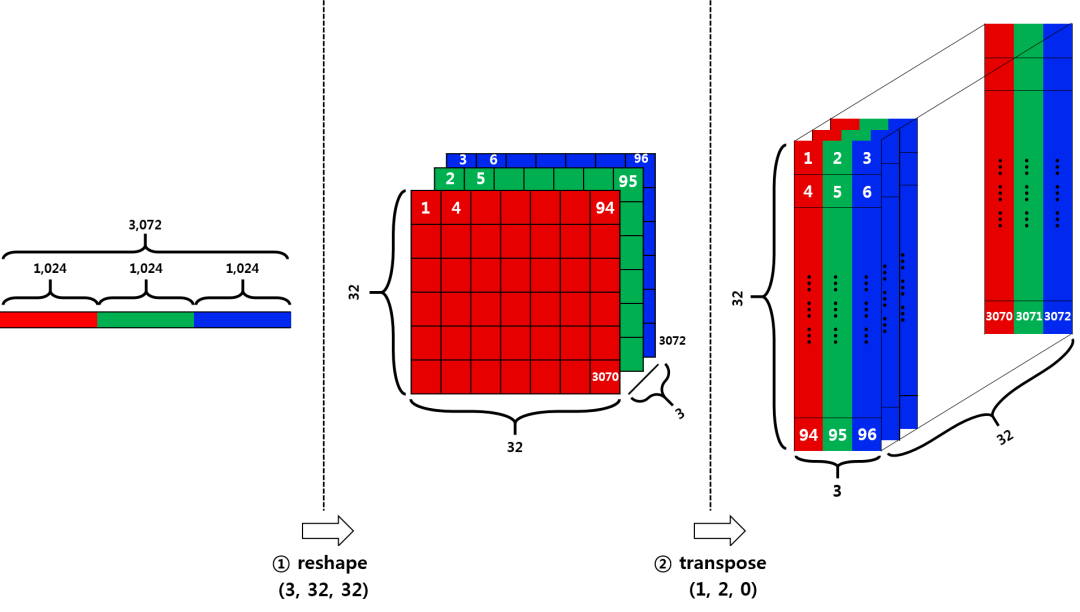
那么,為什么要換軸呢?因為不同程序包對數據的要求不同,我們為了使用它們,需要按照它們對參數的要求來對數據作相應調整。
而有時候,并不需要換軸,只需要更換某個軸上元素的次序即可,例如,
# 變換某個軸上元素的次序
z = x[..., (3, 2, 1, 0)]
x = np.linspace(0, 2*np.pi, 5)
y, z = np.sin(x), np.cos(x)
# 將結果直接傳給輸入 x
np.sin(x, x)
import time
import math
import numpy as np
x = [i for i in range(1000000)]
# math.sin
start = time.process_time()
for i, t in enumerate(x):
x[i] = math.sin(t)
math_time = time.process_time()-start
# numpy.sin
x = np.array(x, dtype=np.float64)
start = time.process_time()
np.sin(x, x)
numpy_time = time.process_time()-start
# comparison
math_time, numpy_time, math_time/numpy_time
<op>
插入到沿軸的所有子數組或者元素當中。<op>.reduce (array=, axis=0, dtype=None)np.add.reduce([1,2,3])
np.add.reduce([[1,2,3],[4,5,6]], axis=1)
np.multiply.reduce([[1,2,3],[4,5,6]], axis=1)
這也是 NumPy 內置的通用函數,如果需要這樣的計算,建議直接使用,不要自己實現。
np.add.accumulate([1,2,3])
np.add.accumulate([[1,2,3],[4,5,6]], axis=1)
# 定義一個 python 函數
def ufunc_diy(x):
c, c0, hc = 0.618, 0.518, 1.0
x = x - int(x)
if x >= c:
r = 0.0
elif x < c0:
r = x / c0 * hc
else:
r = (c-x) / (c-c0) * hc
return r
x = np.linspace(0, 2, 1000000)
ufunc_diy(x)
start = time.process_time()
y1 = np.array([ufunc_diy(t) for t in x])
time_1 = time.process_time()-start
time_1
ufunc = np.frompyfunc(ufunc_diy, 1, 1)
start = time.process_time()
y2 = ufunc(x)
time_2 = time.process_time()-start
time_2
本文主要介紹兩種擴展方式,
#ufunc.c
'''
void ufunc_diy(double <em>x, double </em>y, int size) {
double xx,r,c=0.618,c0=0.518,hc=1.0;
for(int i=0;i<size;i++) {
xx = x[i]-(int)(x[i]);
if (xx>=c) r=0.0;
else if (xx<c0) r=xx/c0*hc;
else r=(c-xx)/(c-c0)*hc;
y[i]=r;
}
}
'''
#ufunc.py
""" Example of wrapping a C library function that accepts a C double array as
input using the numpy.ctypeslib. """
import numpy as np
import numpy.ctypeslib as npct
from ctypes import c_int
array_1d_double = npct.ndpointer(dtype=np.double, ndim=1, flags='CONTIGUOUS')
# load the library, using numpy mechanisms
lib = npct.load_library("lib_ufunc", ".")
# setup the return types and argument types
lib.ufunc_diy.restype = None
lib.ufunc_diy.argtypes = [array_1d_double, array_1d_double, c_int]
def ufunc_diy_func(in_array, out_array):
return lib.ufunc_diy(in_array, out_array, len(in_array))
# 編譯
# gcc -shared -fPIC -O2 ufunc.c -ldl -o lib_ufunc.so
import time
import numpy as np
import ufunc
start = time.process_time()
ufunc.ufunc_diy_func(x, x)
end = time.process_time()
print("ufunc_diy time: ", end-start)
# python test_ufunc.py
# ufunc_diy time: 0.003 - 0.008
# ufunc_diy.h
void ufunc_diy(double <em> in_array, double </em> out_array, int size);
# ufunc_diy.c
void ufunc_diy(double <em>x, double </em>y, int size) {
double xx,r,c=0.618,c0=0.518,hc=1.0;
for(int i=0;i<size;i++) {
xx = x[i]-(int)(x[i]);
if (xx>=c) r=0.0;
else if (xx<c0) r=xx/c0*hc;
else r=(c-xx)/(c-c0)*hc;
y[i]=r;
}
}
# Cython支持 NumPy
# 在代碼中聲明 a = np.array([0,10,20,30])
b = np.array([0,1,2])cimport numpy,使用函數。
#_ufunc_cython.pyx_
""" Example of wrapping a C function that takes C double arrays as input using
the Numpy declarations from Cython """
# cimport the Cython declarations for numpy
cimport numpy as np
# if you want to use the Numpy-C-API from Cython
# (not strictly necessary for this example, but good practice)
np.import_array()
# cdefine the signature of our c function
cdef extern from "ufunc_diy.h":
void ufunc_diy (double <em> in_array, double </em> out_array, int size)
# create the wrapper code, with numpy type annotations
def ufunc_diy_func(np.ndarray[double, ndim=1, mode="c"] in_array not Noa = np.array([0,10,20,30])
b = np.array([0,1,2])ne,
np.ndarray[double, ndim=1, mode="c"] out_array not None):
ufunc_diy(<double*> np.PyArray_DATA(in_array),
<double*> np.PyArray_DATA(out_array),
in_array.shape[0])
# setup.py
from distutils.core import setup, Extension
import numpy
from Cython.Distutils import build_ext
setup(
cmdclass={'build_ext': build_ext},
ext_modules=[Extension("ufunc_cython",
sources=["_ufunc_cython.pyx", "ufunc_diy.c"],
include_dirs=[numpy.get_include()])],
)
# 或者
from distutils.core import setup
import numpy
from Cython.Build import cythonize
setup(
ext_modules=cythonize("_ufunc_cython.pyx", annotate=True),
include_dirs=[numpy.get_include()]
)
# 編譯
python setup.py build_ext --inplace
可以看到多了兩個文件,一個是 _ufunc_cython.c,一個是 ufunc_cython.so(如果是 windows,則是 .pyd)。
c
文件就是
cython
將
pyx
文件解析成一個
c
文件,它不依賴平臺,而
so
或者
pyd
文件,則是將
c
文件進行編譯后的動態鏈接庫,依賴于平臺。 import time
import numpy as np
import ufunc_cython
start = time.process_time()
ufunc_cython.ufunc_diy_func(x, x)
end = time.process_time()
print("ufunc_diy time: ", end-start)
以上就是如何分析NumPy廣播機制與C語言擴展,小編相信有部分知識點可能是我們日常工作會見到或用到的。希望你能通過這篇文章學到更多知識。更多詳情敬請關注億速云行業資訊頻道。
免責聲明:本站發布的內容(圖片、視頻和文字)以原創、轉載和分享為主,文章觀點不代表本網站立場,如果涉及侵權請聯系站長郵箱:is@yisu.com進行舉報,并提供相關證據,一經查實,將立刻刪除涉嫌侵權內容。